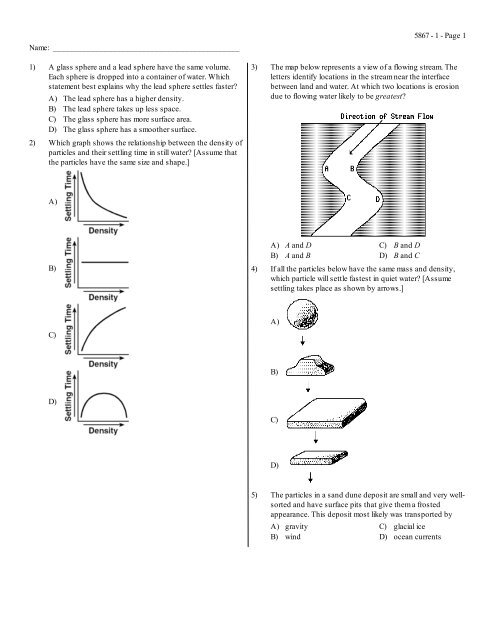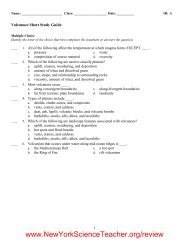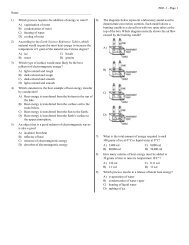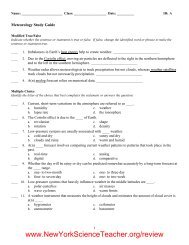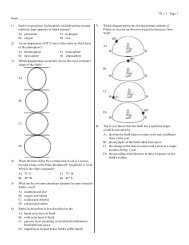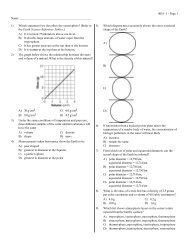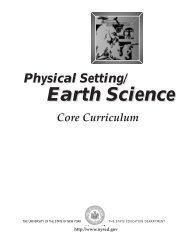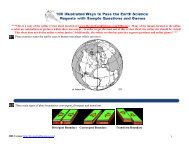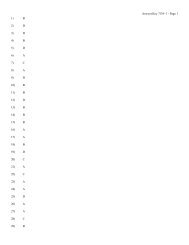Deposition - Earth Science Regents Review
Deposition - Earth Science Regents Review
Deposition - Earth Science Regents Review
You also want an ePaper? Increase the reach of your titles
YUMPU automatically turns print PDFs into web optimized ePapers that Google loves.
Name: ____________________________________________1) A glass sphere and a lead sphere have the same volume.Each sphere is dropped into a container of water. Whichstatement best explains why the lead sphere settles faster?A) The lead sphere has a higher density.B) The lead sphere takes up less space.C) The glass sphere has more surface area.D) The glass sphere has a smoother surface.2) Which graph shows the relationship between the density ofparticles and their settling time in still water? [Assume thatthe particles have the same size and shape.]5867 - 1 - Page 13) The map below represents a view of a flowing stream. Theletters identify locations in the stream near the interfacebetween land and water. At which two locations is erosiondue to flowing water likely to be greatest?A)B)A) A and DB) A and BC) B and DD) B and C4) If all the particles below have the same mass and density,which particle will settle fastest in quiet water? [Assumesettling takes place as shown by arrows.]C)A)B)D)C)D)5) The particles in a sand dune deposit are small and very wellsortedand have surface pits that give them a frostedappearance. This deposit most likely was transported byA) gravityB) windC) glacial iceD) ocean currents
6) The diagram below represents two branches of a valleyglacier. Points A, B, G, and H are located on the surface ofthe glacier. Point X is located at the interface between theice and the bedrock. The arrows indicate the generaldirection of ice movement.5867 - 1 - Page 28) The diagram below shows three beds of sediment depositedat different times in a quiet body of water.The sediment deposited by the valley glacier at position X isbest described asA) sorted according to particle densityB) sorted according to particle sizeC) sorted according to particle textureD) unsorted7) A state of dynamic equilibrium exists in an erosionaldepositionalsystem whenA) the rate of erosion is the same as the rate of depositionB) the rate of erosion exceeds the rate of depositionC) the amounts of kinetic energy and potential energyboth equal zeroD) all sediments are transported to the sea and erosionstopsThe sediment deposited in each bed is best described asA) sorted mainly according to particle shapeB) a mixture of sorted and unsorted particlesC) sorted mainly according to particle sizeD) showing no evidence of sorting9) Which diagram best illustrates a cross section of sedimentsthat were transported and deposited by a glacier?A)B)10) The chart below shows the results of an activity in whichthree samples of copper (A, B, and C) of equal mass weretimed as they settled to the bottom of a column of water.C)D)The differences in the settling time of the three samples areprobably due to difference in theirA) colorB) densityC) shapeD) composition11) Which rock particles will remain suspended in water for thelongest time?A) pebblesB) siltC) clayD) sand12) Which erosional agent typically deposits hills of unsortedsediments?A) ocean wavesB) glaciersC) windsD) streams
13) Four samples of aluminum, A, B, C, and D, have identicalvolumes and densities, but different shapes. Each piece isdropped into a long tube filled with water. The time eachsample takes to settle to the bottom of the tube is shown inthe table below.5867 - 1 - Page 316) Transported sediments are usually deposited at locations inwhichA) the freezing and thawing of water occursB) an increase in the physical weathering of rocks occursC) the chemical breakdown of rocks occursD) a decrease in the speed of the agent of erosion occurs17) The diagram below represents a top view of a river emptyinginto an ocean bay. A-B is a reference line along the bottomof the bay. Which characteristic would most likely decreasealong the reference line from A to B?Which diagram most likely represents the shape ofsample A?A)C)B)14) A large, scratched boulder is found in a mixture of unsorted,smaller sediments forming a hill in central New York State.Which agent of erosion most likely transported and thendeposited this boulder?A) ocean wavesB) running waterD)C) a glacierD) wind15) The diagram below represents a river flowing into a largelake on a hot, sunny afternoon in July in New York State.The river is carrying particles ranging in size from cobbles toclay.A) the density of the waterB) the size of the sedimentsC) the amount of salt in solutionD) the depth of the water18) Compared to a low-density spherical particle, a high-densityspherical particle of the same size will sink through waterA) more rapidlyB) more slowlyC) at the same rate19) The rate at which particles are deposited by a stream is leastaffected by theA) size and shape of the particlesB) velocity of the streamC) stream's elevation above sea levelD) density of the particlesWhen water from the river enters the lake, particles of whichsize will usually settle out first?A) siltB) pebblesC) clayD) cobbles
20) The diagram below represents a stream flowing in thedirection indicated by the arrows.5867 - 1 - Page 421) The chart below indicates the densities of four differentminerals.Which bar graph best represents the relative amounts oferosion and deposition at locations A, B, C, and D in thestreambed?A)If spheres 5 millimeters in diameter of these four minerals aredropped at the same time into a large tube filled with water,which would settle to the bottom first?A) calciteB) quartzC) diamondD) hematite22) Which graph best represents the relationship betweenstream erosion and the kinetic energy of a stream?A)B)B)C)C)D)D)
23) The diagram below represents a side view of a hill (drumlin)that was deposited by a glacier in central New York.5867 - 1 - Page 526) The diagram below represents a river flowing into a largelake on a hot, sunny afternoon in July in New York State.The river is carrying particles ranging in size from cobbles toclay.This hill is most likely composed ofA) cemented sedimentsB) unsorted sedimentsC) horizontally layered sedimentsD) vertically layered sediments24) Which landscape features are primarily the result of winderosion and deposition?A) V-shaped valleys containing well-sorted layers ofsedimentB) U-shaped valleys containing unsorted layers ofsedimentC) terraces of gravel containing unsorted layers ofsedimentD) cross-bedded sand deposits containing finely sortedlayers of sediment25) A low hill is composed of unsorted sediments that havemixed grain sizes. This hill was probably deposited byA) the windB) wave actionC) running waterD) a glacierAt which location would sediments have the most potentialenergy?A) A B) B C) C D) D27) Why do the particles carried by a river settle to the bottomas the river enters the ocean?A) The velocity of the river water decreases as it enters theocean.B) The kinetic energy of the particles increases as theparticles enter the ocean.C) The density of the ocean water is greater than thedensity of the river water.D) The large particles have a greater surface area than thesmall particles.
Questions 28 through 30 refer to the following:5867 - 1 - Page 6The bar graphs below show the percentages by volume of the sediment sizes that are found in four different sediment deposits, A, B, C,and D.28) Which deposits contain particles 0.001 centimeter indiameter? [Refer to the <strong>Earth</strong> <strong>Science</strong> Reference Tables.]A) A and BB) A and DC) C and DD) B and C29) Which deposit contains the highest percentage ofsediments that would stay in suspension for the longesttime before settling?A) deposit CB) deposit BC) deposit DD) deposit A30) What was the most probable agent of erosion thatdeposited the unsorted sediments in deposit B?A) a streamB) ocean watersC) a glacierD) wind
Questions 31 through 33 refer to the following:5867 - 1 - Page 7A group of students collected rounded, well-sorted mineral particles from a stream that flowed over only coarse-grained igneousbedrock. They sorted the particles by mineral type and then mixed equal volumes of all four minerals together and poured the mixtureinto a tube of water. The data table below lists the minerals. Figure A shows the deposit formed on the bottom of the tube as a result ofthe deposition of the particles.31) The experiment was repeated using a second plagioclasesample with the original samples of the other minerals. Whatdifference between the first and second samples ofplagioclase would best explain the change in the pattern ofdeposition shown in figure B?32) As shown in figure A, which mineral appears to have thefastest settling rate?A) olivineB) quartzC) hornblendeD) plagioclase33) The pattern resulting from the deposition of the mineralparticles, as shown in figure A, is best explained by the factthat the particles have differentA) volumesB) circumferencesC) surface areasD) densitiesA) Particles from the second sample of plagioclase hadgreater density.B) Particles from the second sample of plagioclase werelarger.C) Particles from the second sample of plagioclase hadgreater total volume.D) Particles from the second sample of plagioclase hadflatter shapes.
Questions 34 and 35 refer to the following:5867 - 1 - Page 8The diagram below represents a surface and cross-sectional view of a portion of the <strong>Earth</strong> 15 kilometers from a mountain range.34) According to the <strong>Earth</strong> <strong>Science</strong> Reference Tables, whatmust be the size of the boulder?A) greater than 25.6 cm in diameterB) 0.2 to 6.4 cm in diameterC) less than 0.2 cm in diameterD) 6.4 to 25.6 cm in diameter35) The best explanation for the presence of an isolated boulderin this location is that the boulder wasA) transported there by a glacierB) eroded from a limestone cliffC) placed there by a volcanic eruptionD) deposited there by a slow-moving streamQuestions 36 and 37 refer to the following:The maps below show the stages in the growth of a stream delta. Point X represents a location in the stream channel. The cross sectionof a stream shows rock particles transported in the stream at a point close to its source.
36) Which characteristics are most likely shown by thesediments in the delta?A) large cobbles deposited in parallel linesB) round grains deposited in layersC) jagged fragments deposited in elongated hillsD) unsorted mixed sizes deposited in scattered piles5867 - 1 - Page 937) A decrease in the velocity of the stream at location X willusually cause an increase inA) the size of the particles carried by the streamB) the amount of material carried by the streamC) deposition within the stream channelD) downcutting by the streamQuestions 38 and 39 refer to the following:The map below shows a stream flowing into a lake. Letters A through F represent locations in the stream and lake.38) Where would the greatest amount of sediments most likelybe deposited in this system?A) B B) F C) D D) E39) Which kind of sediment would probably be depositedfarthest out in the lake? [Refer to the <strong>Earth</strong> <strong>Science</strong>Reference Tables.]A) siltB) sandC) clayD) pebbles40) A large glass cylinder containing a mixture of sediments of the same density and water is shaken. Which drawing below bestrepresents the result after settling?A) B) C) D)
5867 - 1 - Page 1041) Diagram I below shows the paths of two streams over the <strong>Earth</strong>'s surface. Diagram II shows the longitudinal profile of the majorstream.At which location would the water in the stream have the greatest potential energy?A) B B) A C) E D) C42) The map below shows the top view of a meandering stream as it enters a lake.At which points along the stream are erosion and deposition dominant?A) Erosion is dominant at B and C, and deposition is dominant at A and D.B) Erosion is dominant at A and D, and deposition is dominant at B and C.C) Erosion is dominant at A and C, and deposition is dominant at B and D.D) Erosion is dominant at B and D, and deposition is dominant at A and C.Questions 43 through 46 refer to the following:The cross-sectional diagram below shows the pattern of deposition of stream-carried sediments on the ocean floor.
43) According to the <strong>Earth</strong> <strong>Science</strong> Reference Tables, theminimum velocity of the water required to keep pebblesmoving between points Y and Z is closest toA) 15 cm/secB) 165 cm/secC) 275 cm/secD) 50 cm/sec44) If the stream's erosional rate is equal to its depositional ratebetween points X and Y, the stream is said to be inA) environmental imbalanceB) dynamic equilibriumC) a state of upliftD) a state of subsidence5867 - 1 - Page 1145) If the stream discharge between X and Y increased, the mostlikely result would beA) an increase in the particle size of sediments entering theoceanB) a decrease in the amount of erosionC) an increase in the deposition of sediments between Xand YD) a decrease in the average stream velocity46) Which statement best explains the horizontal sorting of thesediments pictured in the diagram?A) Increased stream velocity carries larger particles fartherinto the ocean than it carries the smaller ones.B) Larger particles settle more quickly than smaller ones.C) Rainfall increases the accumulation of limestone indeeper ocean areas.D) Suspended material and dissolved chemicals settleimmediately.Questions 47 and 48 refer to the following:A mixture of colloids, clay, silt, sand, pebbles, and cobbles is put into stream I at point A. The water velocity at point A is400 centimeters per second. A similar mixture of particles is put into stream II at point A. The water velocity in stream II at point A is80 centimeters per second.47) In lake I, as the stream water moves from point C to point D,its velocityA) increasesB) remains the sameC) decreases48) What will most likely occur when the transported sedimentreaches lake II?A) The largest particles will be carried farthest into thelake.B) The sediment will become more angular because ofabrasion.C) The particles will be deposited in sorted layers.D) Clay particles will settle first.
Questions 49 through 52 refer to the following:5867 - 1 - Page 12The cross-sectional diagram below shows a sediment-laden stream entering the ocean. The ocean is divided into four zones A, B, C,and D.49) In which zone would the stream normally deposit particlesof largest size?A) B B) D C) C D) A50) Which change in the stream system would most likely causethe deposition of larger particles to be farther offshore?A) a decrease in the stream's gradientB) an increase in the density of large particlesC) an increase in the stream's velocityD) a decrease in the quantity of large particles51) Which zone would contain particles mostly in the range of0.05 to 0.10 centimeter in diameter? [Refer to the <strong>Earth</strong><strong>Science</strong> Reference Tables.]A) C B) D C) B D) A52) Which material would most likely be held in suspension inzone D?A) sandB) siltC) cobblesD) colloids


